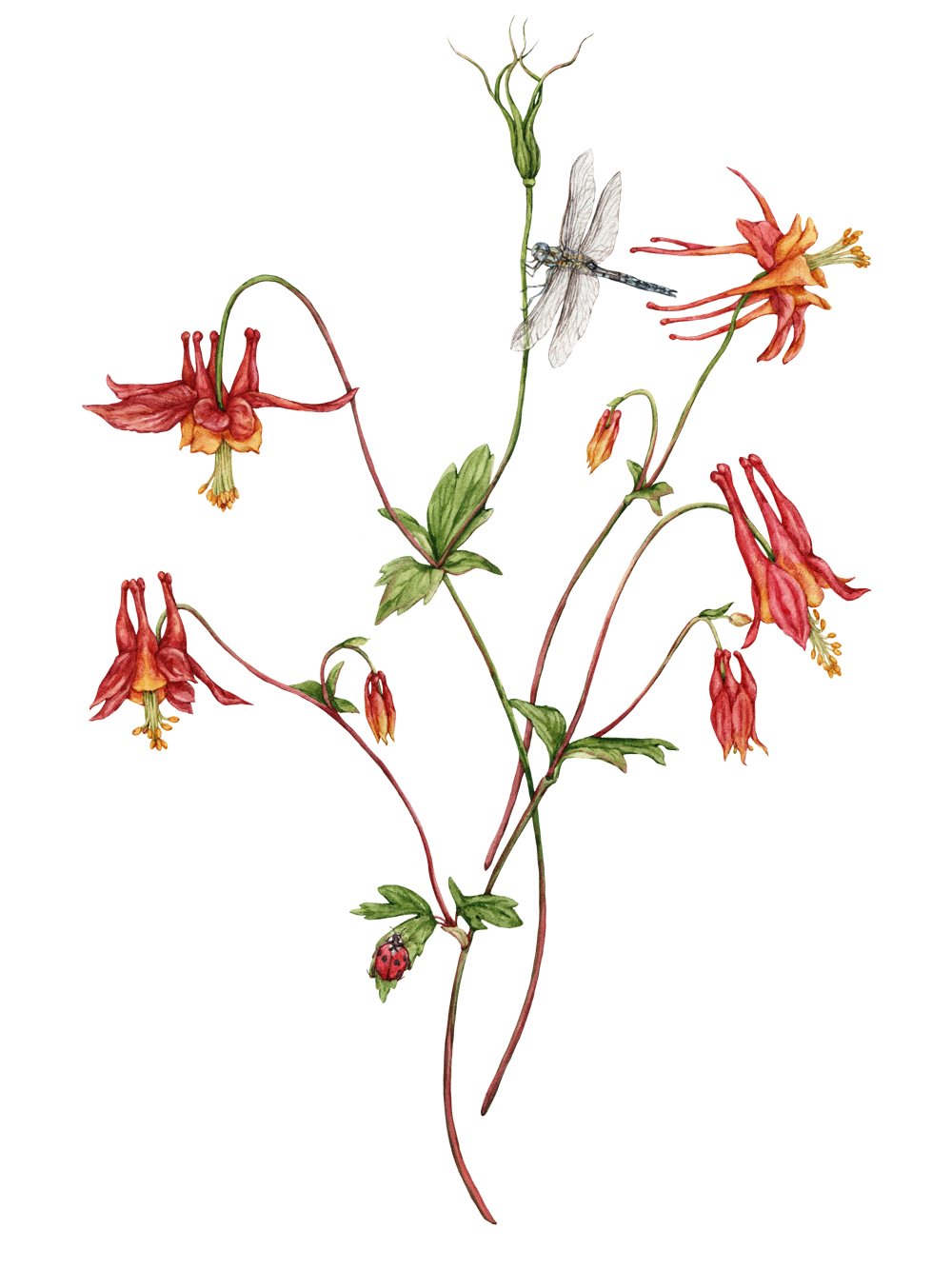Celebrating Pollinator Week Through Botanical Art
Pollinator Week June 16–22, 2025 is an annual celebration of the vital role that bees, butterflies, moths, birds, and other species play in keeping our ecosystems thriving. This year, I marked the occasion by sharing a week-long series of hand-painted watercolor illustrations—each one highlighting a native plant and the pollinator it supports.
As a botanical artist, I’m always inspired by the quiet, essential relationships that exist in nature. These illustrations are part of an ongoing commitment to tell ecological stories through art—to make visible the connections that often go unnoticed.
Here’s a recap of the series:
Day 1 - Milkweed for Monarchs
Milkweed is more than a wildflower — it’s the sole host plant for monarch butterflies. Monarchs lay their eggs only on milkweed, and the caterpillars depend on its leaves for food as they grow. Without milkweed, monarchs simply can’t complete their life cycle.
In this watercolor, I focused on the plant’s tall stems and soft pink blooms to highlight both its beauty and ecological importance. Supporting monarchs starts with planting and protecting native milkweed — a small act with a powerful impact.
Day 2 - Red Clover for Bumblebees
Red clovers (Trifolium pratense) are familiar wildflowers often seen in fields, roadsides, and lawns—but they’re also favorites among long-tongued bumblebees. Their tightly packed, nectar-rich florets are perfectly suited for these bees, offering reliable food throughout spring and summer.
In this watercolor, I focused on the subtle differences between the two clover species, repeating each bloom form across the page to reflect their abundance. These common plants quietly support pollinators at a large scale—and painting them is a reminder that even the humblest flowers play a vital role.
Day 3 - Asters & Painted Lady Butterflies
Asters (Symphyotrichum spp.) bloom late in the season, providing nectar for migrating pollinators like the Painted Lady butterfly (Vanessa cardui). These bright, daisy-like flowers are crucial for supporting butterflies as they make their long journey south in the fall.
In this painting, I paired purple asters with the delicate patterning of the Painted Lady to highlight their seasonal bond. Painting this relationship was a way to honor the role that native fall flowers play in sustaining life after summer’s peak.
Day 4 - Dryas & Alpine Bees
Dryas (Dryas drummondii), also known as yellow mountain avens, is a hardy wildflower found in alpine and subalpine regions of western North America. Its bright, open blooms are among the first to appear after snowmelt, offering a critical nectar source for early-emerging native bees.
This painting captures the simplicity of Dryas and the delicate moment when a small bee pauses at its center. In high-elevation habitats where life is short and conditions are harsh, every bloom counts—and so does every pollinator.
Day 5 -Turtlehead & the Baltimore Checkerspot
Turtlehead (Chelone glabra) is the primary host plant for the striking Baltimore checkerspot butterfly (Euphydryas phaeton), which lays its eggs on the plant’s leaves. The caterpillars depend on turtlehead to survive, while adult butterflies and bumblebees also visit its unusual hooded blooms for nectar.
In this watercolor, I painted both plant and butterfly with a focus on symmetry and structure—mirroring how tightly linked their survival is. Turtlehead grows in wet meadows and stream edges, and planting or protecting it can directly support this beautiful, vulnerable butterfly.
Day 6 - Sphinx Moths & Honeysuckle
Sphinx moths (family Sphingidae) are nocturnal pollinators often mistaken for hummingbirds because of their hovering flight and long, narrow wings. They’re drawn to honeysuckle (Lonicera spp.), whose tubular flowers are rich in nectar and release their fragrance in the evening.
This painting was inspired by the quiet beauty of night pollination. The pairing of honeysuckle and Sphinx moths reminds us that some pollination happens while the world sleeps—and that moths, though less celebrated, play a vital role in our ecosystems.
Day 7 - Red Columbine & Lesser-Known Pollinators
Red columbine (Aquilegia formosa) is known for its vivid red spurs and its connection to hummingbirds, but it’s also visited by dragonflies, solitary bees, and other often-overlooked pollinators. These insects may be small, but they help ensure that columbine continues to bloom year after year.
In this artwork, I painted red columbine alongside a variety of subtle pollinators to shift the focus beyond the usual stars. Celebrating biodiversity means honoring every contributor—even the tiny, quiet ones that keep the system going behind the scenes.
Art with a Purpose
This series isn’t just about painting flowers—it's about showing the relationships that keep our ecosystems in balance. If you're part of an organization working in pollinator conservation, environmental education, or native plant advocacy, I’d love to collaborate.
You can explore more of my botanical and ecological illustration on my portfolio page, or get in touch if you’re looking for custom artwork for your next project.
Follow my art journey on Instagram @annafarba for more botanical illustrations and behind-the-scenes watercolor work.







